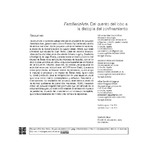Mostrar o rexistro simple do ítem
FamiliarizArte. Del cuento del lobo a la distopía del confinamiento
| dc.contributor.author | Martínez-Vérez, Victoria | |
| dc.contributor.author | Montero-Seoane, Antonio | |
| dc.contributor.author | Sardá Miragaya, Alba | |
| dc.date.accessioned | 2023-01-19T14:51:37Z | |
| dc.date.available | 2023-01-19T14:51:37Z | |
| dc.date.issued | 2022-07 | |
| dc.identifier.citation | Martínez-Vérez, V., Montero-Seoane, A. y Sardá, A. (2022). FamiliarizArte. Del cuento del lobo a la distopía del confinamiento. Revista KEPES, 19(26), 569-600. https://doi.org/10.17151/kepes.2022.19.26.18 | es_ES |
| dc.identifier.issn | 1794-7111 | |
| dc.identifier.uri | http://hdl.handle.net/2183/32365 | |
| dc.description.abstract | [Resumen]:Introducción: el presente trabajo analiza los resultados del proyecto FamiliarizArte, galardonado con el Premio Espiral de educación de ámbito nacional. Dicho proyecto utiliza la mediación artística, a través de la contemplación de cuatro obras: Xentes que ollan (Personas que miran) de Díaz Pardo, Casas de Antonio Tenreiro, Vista da Coruña (Vista de La Coruña) de Urbano Lugrís y Zoolóxico (Zoológico) de Lago Rivera, pertenecientes al fondo pictórico del Museo de Belas Artes da Coruña (Noroeste de España), con el fin de provocar un contexto reflexivo que permita analizar el impacto de la Covid-19. Método: para ello, se realiza una propuesta de actividad entre tres instituciones: el CIFP Anxel Casal, que actúa como proponente, la Escuela Infantil de Montealto, quien acoge e impulsa el proyecto y el Museo de Bellas Artes, quien cede su fondo pictórico, para la composición de una narrativa visual que sirve como marco contemplativo y reflexivo. Resultados y conclusiones: los resultados del proyecto, analizados a través de la técnica cualitativa de panel (De Keulenaer, 2008), muestran cómo las pinturas elegidas han permitido que las familias de la escuela construyan un relato emocional de lo acontecido durante la pandemia, situando las vivencias en un contexto manejable, que reflexiona acerca del miedo y da forma a la esperanza. | es_ES |
| dc.description.abstract | [Abstract]: Introduction: this article analyzes the results of the FamiliarizArte Project, awared with the Spiral Award for Education at the national level. This Project uses artistic mediation through the contemplation of four Works: Xentes que ollan (People watching) by Díaz Pardo, Casas (Houses) by Antonio Tenreiro, Vista da Coruña (View of La Coruña) by Urbano Lugrís and Zoolóxico (Zoo) by Lago Rivera, belonging to the pictorial background of the Museo de Belas Artes da Coruña (Northwest Spain) in order to provoke a reflective context that allows analyzing the impact of Covid-19. Method: to do this, an activity proposal is carried out between three institutions: the CIFP Anxel Casal, which acts as a proponent, the Montealto Children's School, which hosts and promotes the project and the Museo de Belas Artes da Coruña, which donates its pictorial collection for the composition of a visual narrative that serves as a contemplative and reflective framework. Results and conclusions: the results of the project, analyzed through the qualitative panel technique (De Keulenaer, 2008), show how the chosen paintings have allowed the families of the school to build an emotional story of what happened, placing the experiences in a manageable context, which reflects on fear and shapes hope. | es_ES |
| dc.language.iso | spa | es_ES |
| dc.publisher | Universidad de Caldas | es_ES |
| dc.relation.uri | https://doi.org/10.17151/kepes.2022.19.26.18 | es_ES |
| dc.rights | Atribución 3.0 España | es_ES |
| dc.rights.uri | http://creativecommons.org/licenses/by/3.0/es/ | * |
| dc.subject | Covid-19 | es_ES |
| dc.subject | Educación | es_ES |
| dc.subject | Arte | es_ES |
| dc.subject | Co-creación | es_ES |
| dc.subject | Education | es_ES |
| dc.subject | Art | es_ES |
| dc.subject | Co-creation | es_ES |
| dc.title | FamiliarizArte. Del cuento del lobo a la distopía del confinamiento | es_ES |
| dc.type | info:eu-repo/semantics/article | es_ES |
| dc.rights.access | info:eu-repo/semantics/openAccess | es_ES |
| UDC.journalTitle | Revista KEPES | es_ES |
| UDC.issue | 26 | es_ES |
| UDC.startPage | 569 | es_ES |
| UDC.endPage | 600 | es_ES |
Ficheiros no ítem
Este ítem aparece na(s) seguinte(s) colección(s)
-
GI-INCIDE - Artigos [26]






